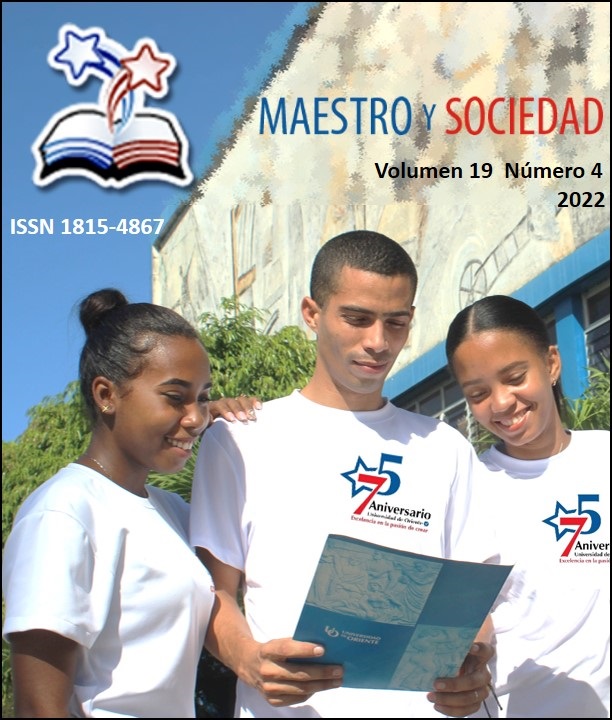Lexical-semantic relationships as a way to work with the vocabulary in the Secondary Basic educational level
Lexical-semantic relationships as a way to work with the vocabulary in the Secondary Basic educational level
Keywords:
vocabulary, polysemy, junior high school, lexical-semantic relationshipsAbstract
The treatment of vocabulary, from the lexical-semantic relations at the Secondary Basic educational level, constitutes an essential objective to achieve efficient communicators. In the present work, the treatment of synonymy, antonymy and polysemy as lexical relations that teachers must master to improve the teaching-learning process at this educational level is deepened, and favor the enrichment of vocabulary in students so that may be able to use the mother tongue accurately in different contexts of action, through the appropriate use of lexical units. The use and triangulation of theoretical and empirical methods allowed the design of a typology of teaching tasks that, while serving as tools for the teacher's work, make it easier for the student to use synonyms and antonyms consciously in their communication at the Secondary educational level Basic.
References
Baralo, M. (2000). El desarrollo de la expresión oral en el aula de ELE. Carabela, 47, 5-36. https://cvc.cervantes.es/ensenanza/biblioteca_ele/carabela/pdf/47/47_005.pdf
Casas, M., Bosch, D. & González, N. (2005). Las competencias comunicativas en la formación democrática de los jóvenes: describir, explicar, justificar, interpretar y argumentar. Enseñanza de las ciencias sociales, (4), 39-52. https://www.redalyc.org/pdf/3241/324127616006.pdf
Causse Cathcart, M. (1998). El léxico como el reflejo de factores socioculturales en la comunidad santiaguera Los Hoyos: estudio sociolingüístico. [Tesis de Maestría. Universidad de Oriente].
Clavería, G. & Planas, C. (2001). La homonimia en la lexicografía española. Nueva revista de filología hispánica, 49(2), 281-306. https://www.jstor.org/stable/40300016
Cruse, D. A. (2004). Facetas léxicas y metonimia. Ilha Do Desterro a Journal of English Language, Literatures in English And Cultural Studies, (47), 073-096. https://periodicos.ufsc.br/index.php/desterro/article/view/7348
Cruz Palacios, Y. (2013). El Tratamiento del léxico en función del desarrollo de la competencia comunicativa del docente en formación del área de las Humanidades. https://repositorio.uho.edu.cu/handle/uho/5034
Garrido, J. (2006). Léxico y discurso. De Miguel, Azucena Palacios & Serradilla.
Halliday, M. A. K. (1986). An Introduction to Functional Grammar. Arnold.
Martín Gascueña, R. (2010). Relaciones semánticas de inclusión en las unidades léxicas. https://e-archivo.uc3m.es/bitstream/handle/10016/9986/TESIS%20R?sequence=6
Oramas, M. M. (2012). Estrategia Didáctica para la preparación teórico-metodológica de los profesores de español y literatura para la enseñanza del léxico y el desarrollo de la competencia lexical en el bachillerato moreliano. Universidad de Ciencias Pedagógicas Enrique José Varona.
Quiñones Reyna, D., Ávila Pérez, Z., & Rodríguez Zaldívar, I. (2005). El contenido de la enseñanza y la tarea docente: una propuesta desarrolladora. V Congreso Internacional Virtual de Educación. http://sedici.unlp.edu.ar/handle/10915/24571
Sanromán Vilas, B. & Carrasco Gutiérrez, Á. (2019). Categorías semiléxicas: Haciendo balance entre el contenido léxico y la función gramatical. Revista Española de Lingüística.
Published
How to Cite
Issue
Section
License
Copyright (c) 2022 Miladis de la Rosa-Marrero , Yaquelin Cruz-Palacios, Melba Estévez-Lobaina , Yamileydis Soca-Rigñack

This work is licensed under a Creative Commons Attribution-NonCommercial-NoDerivatives 4.0 International License.
This journal provides immediate open access to its content, based on the principle that offering the public free access to research helps a greater global exchange of knowledge. Each author is responsible for the content of each of their articles.



























 Universidad de Oriente
Universidad de Oriente 